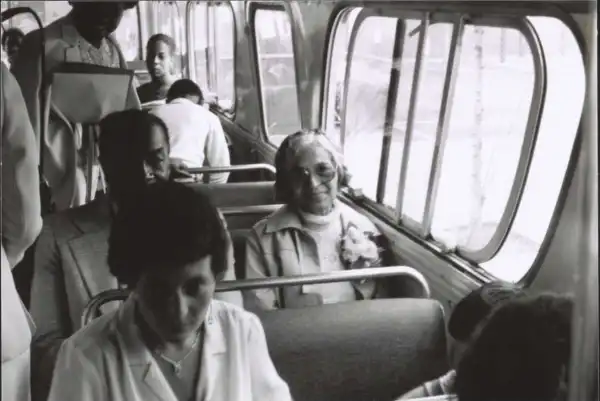Sustaining Rosa Parks Struggle Transit Equity
Transit Equity Day, a nationwide day of action, honors Rosa Parks' legacy and highlights the importance of equitable public transit.
Every February, the Labor Sustainability Network coordinates Transit Equity Day, a nationwide day of action that highlights the importance of equitable public transit in ongoing struggles for civil rights.
This year's action, on February 5, falls on the day after what would've been the 111th birthday of Rosa Parks. Born in Tuskegee, Alabama, Parks was a lifelong civil rights activist. When she died in 2005, she became the first woman in American history to lie in honor at the U.S. Capitol.
Though Parks's work ranged from defending political prisoners to anti-war activism, she is often best remembered for her contribution to transit equity. Refusing to surrender her bus seat to a white passenger, her arrest sparked the 1956 Montgomery Bus Boycott. The 13-month boycott ended with a U.S. Supreme Court ruling: public bus segregation is unconstitutional.
Parks's activism didn't stop there. After moving to Detroit, she engaged in an "even more diverse" range of political activities -- fighting for dignity, democracy, and racial justice until the day she died.
"The struggle continues," Parks always insisted. "Don't give up and don't say the movement is dead," remained her mantra.
One way we can honor Parks's legacy is by continuing her struggle for transit equity. To do so, we must first survey the current landscape of transit inequity.
Today, transit segregation takes a different form: a public-private divide that burdens the working class and punishes the car-less.
In 1956, the same year of the Montgomery Bus Boycott, President Eisenhower signed the Federal Aid Highway Act, investing billions into the interstate system. This marked a milestone in infrastructure policy and a shift in infrastructure investments -- cementing the United States as a "car country."
Car-centric infrastructure continued to receive billions in federal funding while allocations for public transit were restricted to "capital investments" (i.e., new buses or rail lines). This meant that the majority of funds had to come from local and state governments -- leaving public transit perpetually underfunded.
Between 1950 and 2019, U.S. public transit ridership fell from 17.2 billion trips to 9.9 billion, despite a population increase of 177 million in the same period.
For many Americans today, mobility means reliable automobile access. Nearly 70 percent of Americans get to work by driving alone and almost half have no access to public transit whatsoever. Those with access aren't much better off -- 40 percent of buses and 25 percent of rail are in some state of disrepair.
But reliable automobile access is linked to class. Cars are costly: by using public transit, commuters can save between $12,306 and $16,837 annually. That's a lot, especially for low-income Americans -- who are more likely to take public transit than any other income group.
Take New Orleans for example. A third of public transit riders live in poverty, compared to only 9 percent of those who drive cars. Meanwhile, the median income of public transit riders is roughly half that of all commuters -- $15,711 and $31,017 respectively. From Albany to Albuquerque, this disparity exists in most U.S. cities.
Yet public transit's exclusionary design often disadvantages the very people who depend on it most. According to the Urban Institute, local governments tend to fund transit more generously in neighborhoods with lower levels of poverty and higher shares of white residents -- despite poor people and people of color being far more likely to use public transit.












Comments on Sustaining Rosa Parks Struggle Transit Equity